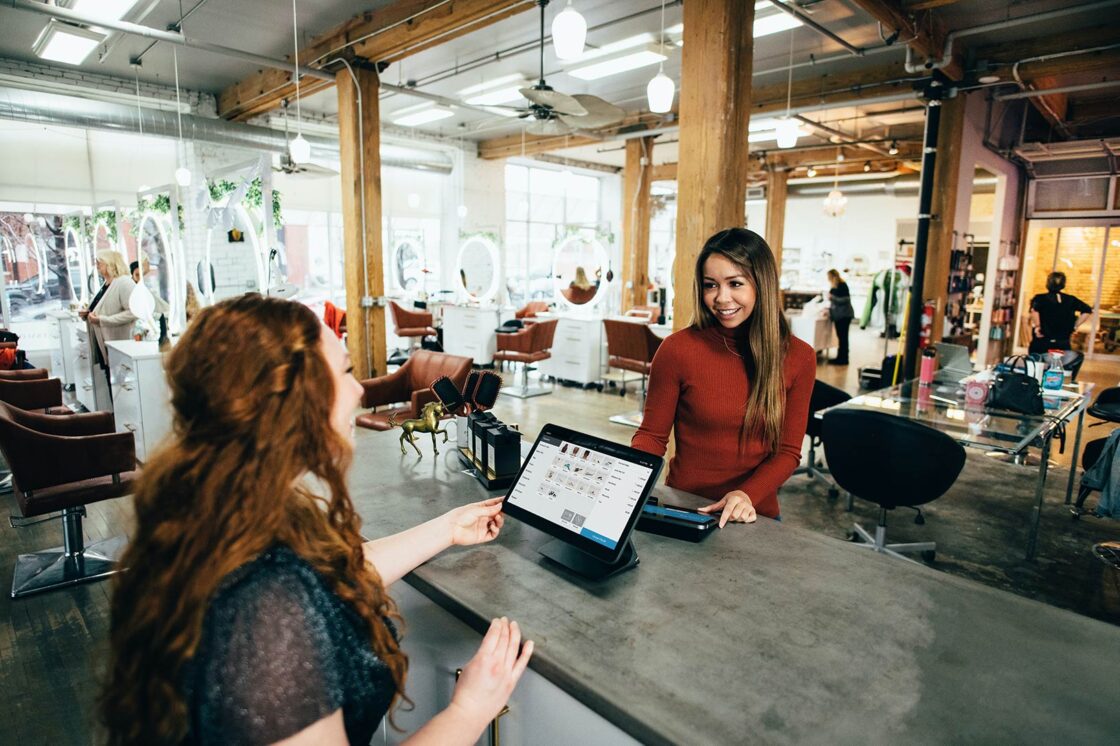
There is a constant debate: should you attract new customers or increase the loyalty of the existing ones?
Many studies show that winning a new client is more expensive than encouraging an existing one to choose your brand over another. More than five times, to be precise. That’s where you should focus on customer loyalty.
Who are loyal customers? They are the ones who keep coming back to your business and putting money into it over time. They feel connected to your brand, like what you offer, and are willing to buy it. These customers are hard to find, but once found, they can be very profitable for your company.
The problem is that most companies don’t know how to create strong relationships with their consumers. There are three key methods for doing that:
- consistent communication;
- collaboration;
- appreciation.
You have various channels to communicate with your audience, including social media, email, the website, podcast applications, and so on. In this article, we’ll talk about email newsletters. We’ll analyze what you can do to keep people engaged with your brand and boost their loyalty.
Factors Influencing Customer Loyalty: Satisfaction, Trust, and Emotional Connection
Marketers generally agree that it’s important to foster customer loyalty. It brings the benefits such as:
- increasing customer spending;
- minimizing customer churn;
- improving business performance;
- ensuring positive word-of-mouth to gain more customers.
But what impacts loyalty? It goes without saying that the product itself should be competitive, fairly priced, and offer superior value. But apart from the product, there are other factors contributing to building customer loyalty, such as satisfaction, trust, and emotional connection.
1. Satisfaction
Customer satisfaction illustrates how a client perceives a product, service, or brand. Let’s say a person buys something from a store. You can send them a survey to measure their satisfaction level. Such a survey may show positive results as the person is overwhelmed with getting a new item.
But you should be careful that the purchase journey doesn’t stop after getting a thing. A lot may happen after leaving the store, from not knowing how to use the product to breaking it. You should ensure proactive and excellent customer service to resolve the arising issues.
So while customer satisfaction may not always guarantee loyalty, it’s crucial in building a successful relationship between businesses and customers. Overall satisfaction reflects past interactions, shapes expectations, and evolves with each new interaction.
2. Trust
Trust is another vital component of customer loyalty. If a shopper believes a company, they expect it to act as promised. The higher trust, the more likely a prospect will convert into a customer, like the product or company, and become loyal.
Imagine one retailer with a stellar reputation for prompt deliveries and excellent customer support. The other has a questionable track record. Naturally, you would lean towards the retailer you believe in.
Building trust requires consistent actions and transparent communication. You should deliver on promises, provide reliable products or services, and promptly handle customer issues.
3. Emotional Connection
The third pillar of loyalty is emotional connection. It denotes positive feelings and bonds between a client and a company, making people come back to the store. Research indicates that when consumers feel emotionally connected to a brand, 70% of them tend to spend twice as much or even more. In contrast, less than half (49%) of consumers with low emotional engagement exhibit similar spending habits.
Marketers often appeal to our emotions when promoting products. How will this item make us feel? Will it make us feel confident, joyful, or free? By nurturing particular associations with your brand, you can ensure your company will pop up in the customers’ minds when they want to buy something.
Emotionally devoted consumers also spread a positive message to others. For example, they may share photos on social media, increasing your reach and attracting more shoppers.
The Benefits of Leveraging Email Marketing for Customer Loyalty
Email marketing remains one of the most popular and beneficial forms of audience interaction. An email has a 21.5% average industry open rate, making it useful for building strong bonds with your clients. It’s also one of the most accessible and affordable means of communication. Email marketing shows a massive return on investment (ROI): $36 for every $1 spent on average.
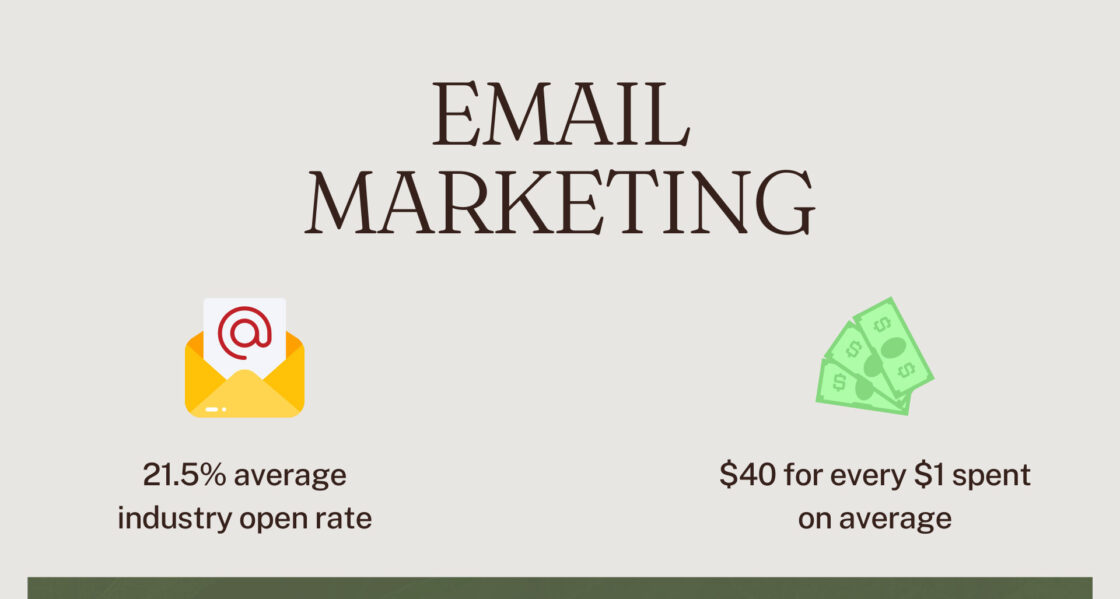
Here are five more reasons why you should consider customer loyalty email marketing:
- The ability to send follow-up emails after a purchase. You may quickly get in touch with former clients using email marketing to solicit their opinions, advertise exclusive deals, or persuade them to provide a review;
- Providing a direct line of communication. Email marketing helps you establish strong client relationships by sending them valuable and relevant content, including discounts, new releases, and educational materials.
- Reducing cart abandonment. You can connect with customers who didn’t complete their purchase and left. You can offer complementary items to improve the shopping experience when reminding them about their abandoned shopping carts.
- Enhancing brand visibility and recognition. Customer loyalty email success relies on consistency. You should send messages often enough to keep the brand top-of-mind but not irritate users with excessive emails. Emails let you reinforce the brand image and tone of voice and increase brand recognition. All of this, in turn, can lead to increased loyalty and repeat business from your audience.
- Boosting customer engagement. Email marketing works well for targeted and personalized campaigns. Once you understand and segment the audience, you can spot similar interests and tailor your messages to resonate with specific groups, leading to higher engagement and interaction.
Using Emails to Build Customer Loyalty: 7 Tips to Consider
Now that you understand the customer loyalty email potential, let’s review some of the ways to introduce it into your business. From launching loyalty programs to offering incentives and bonuses, you can dive deep into various types of email conversations.
1. Personalize Emails with the Recipient’s Name and Other Relevant Information
Once people subscribe to your email newsletter, you can leverage their information and show you value them. Personalizing emails is one of the easiest and most proven ways. Personalization is the process of tailoring elements and content to each user.
For example, instead of saying, “See our new collection,” you can say, “Harry, look at our new collection.” Being a simple step for you, it demonstrates the effort in making the letter relevant to users.
As consumers get dozens of promotional letters daily, such a trick may set you apart from the competition. As a result, their loyalty will get stronger over time. That’s what Skillshare does in its email marketing.
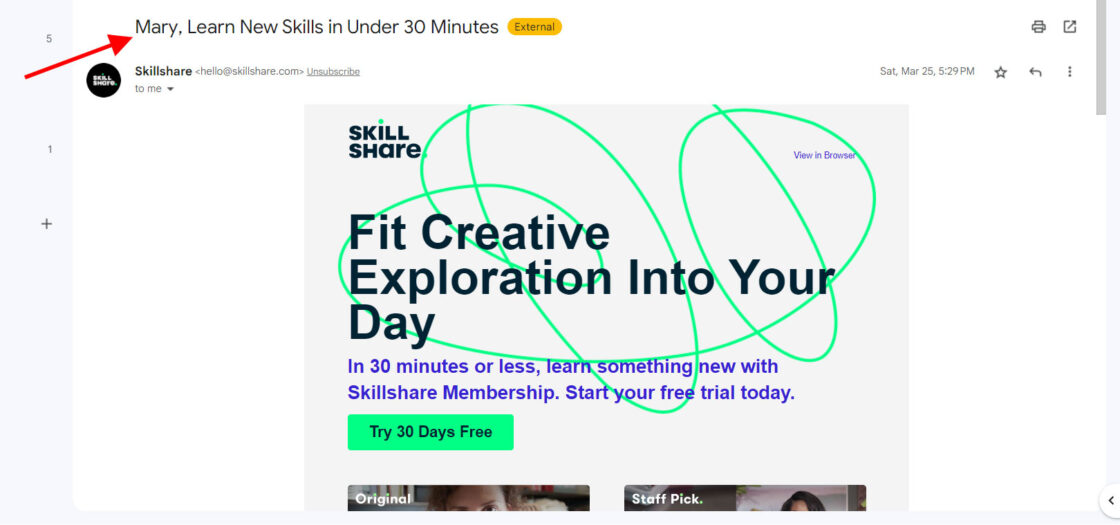
Personalization may take more advanced forms, such as adapting email copy to users’ needs, purchase history, gender, location, etc. Suiteness, an online booking platform, sends personalized analyses of its customers to look back on their previous experiences and encourage recipients to order more.
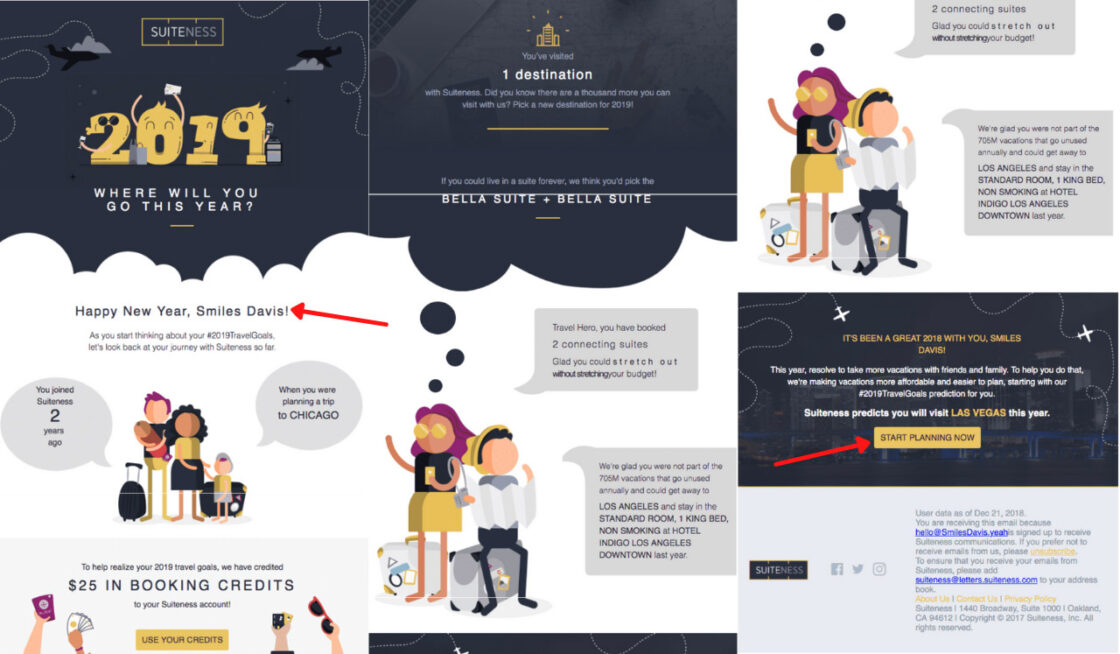
According to Campaign Monitor research, subject line personalization improves open rates by 26%, and segmented campaigns boost email revenue by 760%.
To personalize your customer loyalty email, you need data. How can you obtain the necessary information? Consider the following tips:
- Add extra fields to capture subscriber details.
- Integrate email marketing tools with CRM, eCommerce, or accounting systems to gather extra subscriber details.
- Leverage APIs to integrate email platforms with third-party software for effective segmentation based on customer data.
- Track browser activity to gather behavioral data for personalized emails with product recommendations, cart abandonment reminders, and dynamic content.
2. Provide Valuable Content and Company Updates
Another way to build loyalty is to give special treatment to subscribers. It includes sharing exclusive content, brand news, and behind-the-scenes stories to make people feel part of something special.
Remember about content relevancy. Your customer loyalty email should appeal to the target audience and reflect the brand values. For example, presenting a selection of top email software to a car retailer’s subscribers is not the best idea. It’s also not advisable to keep promoting out-of-stock merchandise. Speak to your audience in their language. This idea encompasses the following principles:
- Follow the brand’s tone of voice. If you sound professional on the website and social media, you shouldn’t use too many informal phrases in emails too. Stay consistent across all channels and adhere to your style guide if you have it.
- Consider inclusivity. As your readers may not be native English speakers, they may misunderstand some jokes, expressions, and references. That’s where email localization may help. Or you can at least employ simple language to deliver your key message.
- Look through customers’ eyes. It’s about discovering and highlighting the product benefits over its features. A polyester T-shirt may say nothing. But a T-shirt that is perfect for sport, dries fast, and holds printed designs well can be a game changer.
Suppose you’ve found out that your audience values social responsibility initiatives. In fact, nearly 80% of people choose brands that are consistent with their personal values. It creates numerous opportunities to showcase your dedication to a better future, whether in environmental protection or supporting minorities.
A case in point is Happy Human. The seller provides tips on making the holiday season more sustainable.
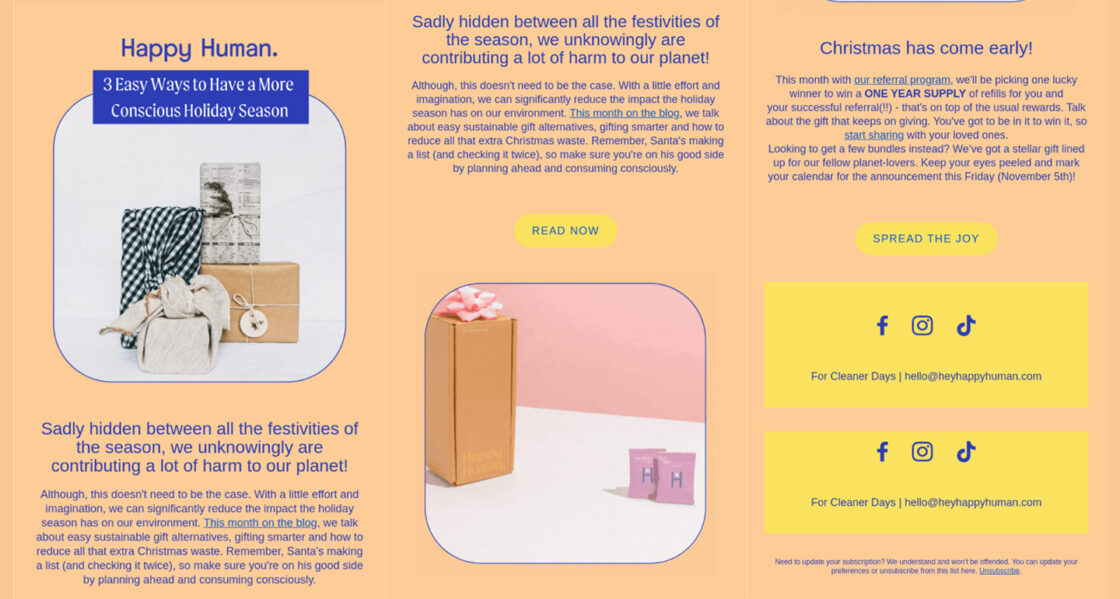
3. Ask for Feedback and Respond to Inquiries Promptly
Knowing clients’ opinions about your products and website can be a significant step toward enhancing customer loyalty. That’s why you should send surveys and encourage shoppers to leave feedback.
The first step towards getting reviews is by asking for them. Make sure the question is easy for people to answer. Remember that customers are often busy or unwilling to write detailed reports.
So instead of requesting their opinion on your customer service like “What do you think about your previous experience?”, try “Was our customer service good or bad? What makes you think so?”.
A quick yes-or-no question is far easier for people to respond to than a lengthy survey. It also applies to ready-made survey templates where they only need to insert the necessary words. Here are several tips on feedback collection:
- Reduce the number of required fields.
- Specify how much it takes to complete them.
- Ask only what you need and nothing more, and your survey will become more user-friendly.
That’s where NPS (net promoter score) survey may also help. Ask consumers whether they will recommend your store to their friends. Expand the customer loyalty email by adding a place to leave more extensive feedback, complaints, or praise.
A little encouragement may increase the desire to write a review. Assign special points and rewards for recording a video review or writing a comment on the website. Allow buyers to redeem these points on the next order. An American retailer, Finish Line, promises a chance to win a $100 gift card for sharing feedback.

As clients like being valued, you should show your desire to act on the feedback. Make improvements and send reports to the loyal audience and highlight your achievements. Employ automation to streamline the above processes. For example, send automated emails after completing a purchase or after abandoning a cart.
4. Offer a Loyalty Program
We’ve discussed several ways to show your appreciation to clients. But why not thank them for their loyalty with points, money, or gifts? That’s what a rewards program is about. There are various ways to incentivize customers to enroll in these programs, including:
- early access to or notification about new products;
- access to sales before they start for the rest of the shoppers;
- service upgrade or free merchandise;
- unique perks like free shipping or easy returns;
- member-exclusive discounts.
Why should you launch loyalty programs? First of all, customers get rewarded for their loyalty, making it more pleasant to return to the store. But apart from ensuring repeat purchases and positive emotions, they can provide you with crucial client information. The difference between anonymous purchases and loyalty programs is that you can identify the following details:
- preferred products to buy together;
- the most effective perks;
- purchase frequency and history;
- spending patterns and budget preferences;
- communication preferences (e.g., email, SMS, mail).
There are several types of programs, including rewards, VIP, and point systems. Once you determine the desired type of program, you can organize the email marketing strategy. Suppose you have a VIP program. How can you design a customer loyalty email to engage and retain your valued customers?
One of the great examples is to send personalized emails that highlight their VIP status, exclusive benefits, and upcoming rewards they can unlock. Here is how McDonald’s appeals to its subscribers to join the rewards program:
- It explains how to do it.
- It shows the benefits of registering in the program.
- McDonald’s leverages beautiful images, compelling calls to action, and a sense of urgency (the offer will expire in 14 days).
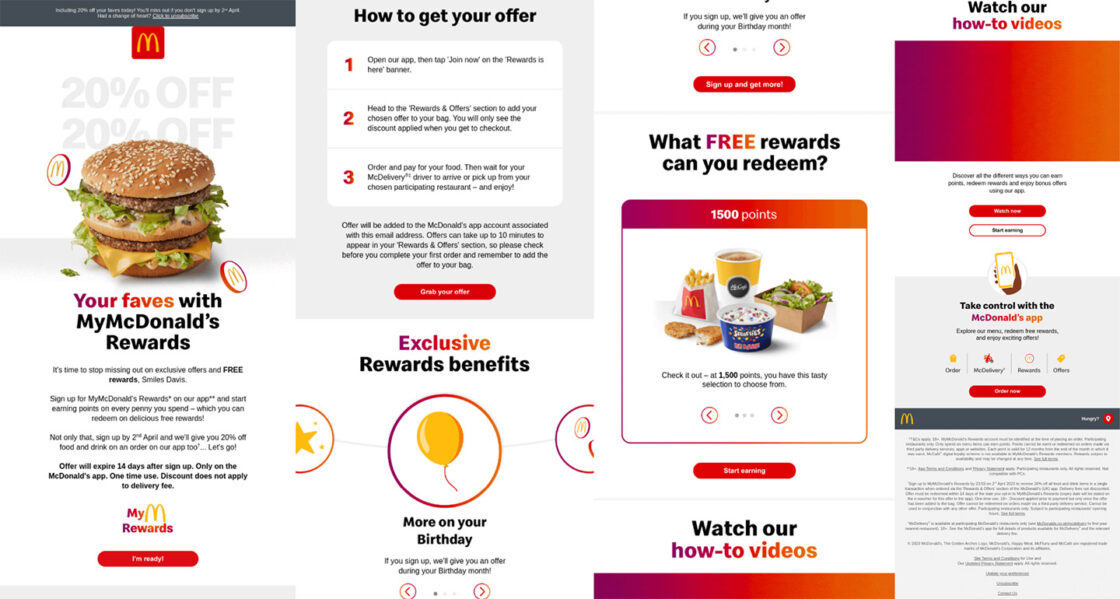
5. Encourage User-Generated Content
User-generated content (UGC) is a powerful digital marketing and advertising tool. It’s content shared by customers highlighting a brand. What makes it powerful? It allows potential audiences to see the value of a brand through the eyes of consumers rather than directly from the brand itself.
It’s like a personal recommendation from a friend. UGC may be unprofessional, like a photo taken in the kitchen rather than in a sophisticated setting. It may depict people with the same problems and struggles rather than polished models. It can be spontaneous, making it unique and emotion-driven. As customers don’t get paid for it, such content looks genuine and trustworthy.
UGC fits various digital platforms such as email, webpages, and social media, driving engagement and sales conversions. But most of all, it strengthens loyalty. How? Here is how it works when incorporated into the email marketing strategy:
- UGC providers feel appreciated for getting exposure on your channels. When customers see their own content or that of others like them, it creates a sense of belonging and community. Such personal touch comes down to a deeper emotional connection.
- Prospective customers, in turn, trust the company more, which can positively influence customer loyalty.
Below you will find screenshots of the Oka-B customer loyalty email. The retailer asks recipients to share photos on social media and tag the brand account to get featured on its social media feeds and stories.
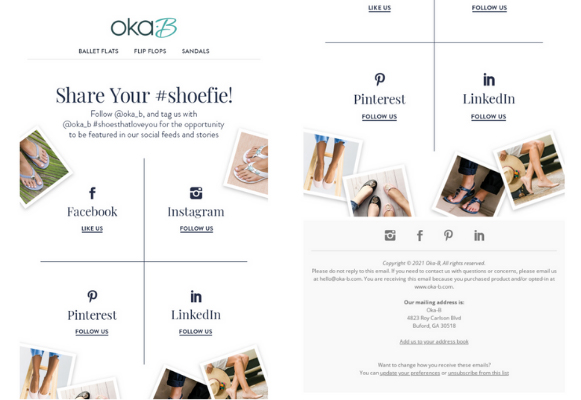
6. Harness the Power of Exclusivity
Everyone has experienced the so-called “main character syndrome” at least once. We expect the world to exist to satisfy our needs and get irritated when something goes south. We believe that everyone is bothered about our lives. So brands should consider this feeling and tap into it to influence purchasing decisions.
How can you make people feel like the most important person in the universe? We’ve already suggested personalizing content. Another approach is accompanying clients on their purchase journey, from welcome emails to birthday wishes and gratitude emails.
If you want to choose a tried and tested strategy, go for birthday emails. Many companies provide bonuses or discounts to customers on their birthdays. But even if it’s not your case, send sincere congratulations to demonstrate to others that you are thinking of them. Take a look at the newsletter example from Dooney & Bourke. The renowned American designer of fine leather and fabric accessories presents a minimalistic letter with a unique discount code.
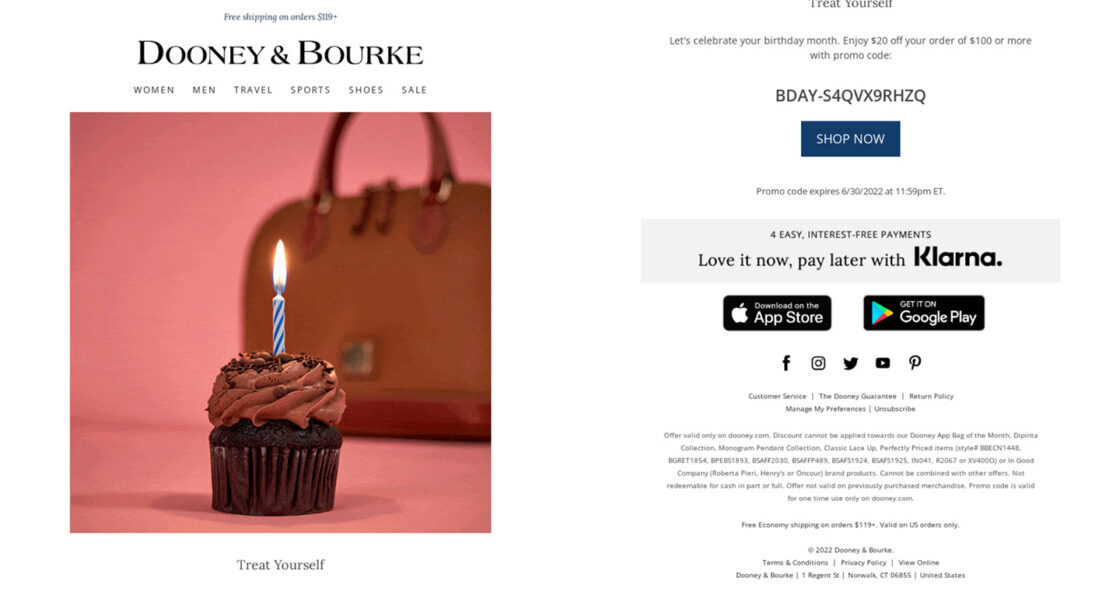
More innovative special day ideas may range from obscure national awareness days to creative personalized celebrations. For example, the first purchase anniversary or the date of joining the loyalty program. Acknowledge unique milestones in your customers’ lives to boost loyalty.
7. Optimize Subject Lines, Email Frequency, and Content
Remember that there are no rigid rules. While some tactics may work, others may not bring the expected results. That’s why you should constantly optimize email strategies to find the key to your audience.
Email testing and optimization refers to the process of identifying what content, incentives, subject lines, and products raise the most interest among your target audience. The end goal is to expand the email list, get more clicks, and strengthen loyalty.
One of the most popular email testing methods is A/B testing. Tweak the subject line length, wording, and CTAs and deliver send-outs at various times of day and week to find the best variant. But note that A/B testing is about comparing two email versions with only one different element.
Wrapping Up
Customer loyalty is as crucial as customer acquisition. And the best part is that it’s a passive source of benefits. It can lead to increased sales, reduced customer churn, improved performance, and positive word-of-mouth referrals.
We’ve examined three factors contributing to loyalty: customer satisfaction, trust, and emotional connection. Consider them when building email marketing strategies. To leverage email marketing for customer loyalty, follow the recommendations from the article, including:
- personalizing emails;
- sharing valuable content and company updates;
- collecting and acting upon feedback;
- launching a loyalty program to reward customers and incentivize repeat purchases;
- incorporating user-generated content;
- congratulating clients on special occasions;
- regularly improving and testing send-outs.
Start drafting and sending value-packed emails and see customer loyalty grow!
Get started with email marketing
Create beautiful email newsletters for free with Get a Newsletter and reach your subscribers and customers in a heartbeat.
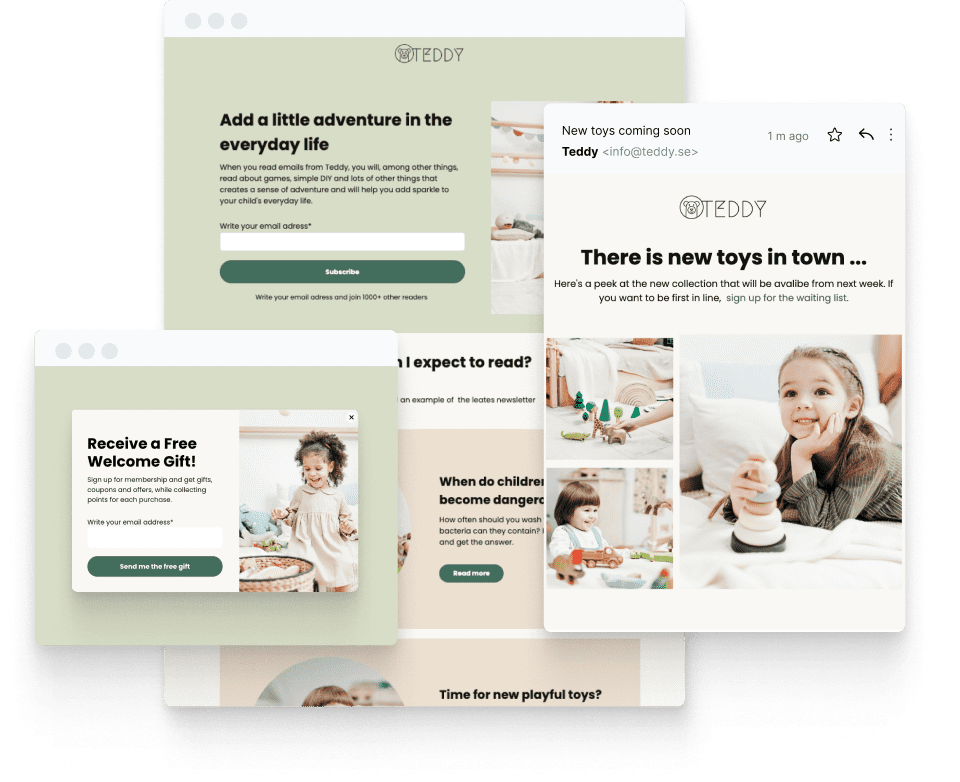

Kate Parish
Kate Parish is a chief marketing officer at Onilab. She has almost a decade of experience in the company and is still enthusiastic about every aspect of digital marketing. Kate sees the marketing mission in ensuring sustainable business growth. For this purpose, she helps companies and readers create efficient campaigns, solve common problems, and enhance crucial website metrics, such as conversions, bounce rates, and others.
Leave a Reply